Why white residue appears in the dishwasher and how to get rid of it
Washing dishes in a machine is very convenient, but it cannot be said that this technique is without its drawbacks.The quality of processing may decrease immediately after installing the device or after some time. The most unpleasant problem for housewives is the white residue in the dishwasher that settles on the surface of the dishes. How to fix it?
You will learn everything about the reasons for the appearance of mineral deposits inside the dishwasher from the article we presented. We will tell you how to prevent formation and how to clean it off if it has managed to settle. We will tell you what rules to follow during the operation of the equipment, ensuring the extension of its working life.
The content of the article:
Reasons for the formation of plaque on dishes
White flakes and stains in the dishwasher are limescale. In a centralized water supply, the water is hard and contains impurities of salts such as calcium, magnesium, etc. Owners of an autonomous water supply system are not immune from this problem, especially if water is drawn from cracks in limestone rocks.
When heated, these substances transform into a white precipitate called scale. This is the most common cause of whitish spots on washed dishes.
A plaque of similar composition forms inside the kettle. To improve the situation, manufacturers have included a special module in the design of dishwashers - an ion exchange system.
This is a container filled with a resinous filler, into which regenerating salt is added.When the water entering the machine passes through an ion exchanger, chloride ions neutralize metal salts and soften the water.
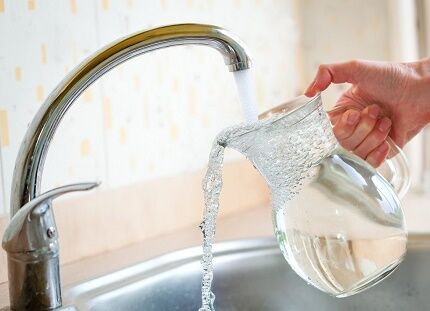
The lack of salt or its insufficient amount leads to the appearance of plaque. But the reasons for the lack of this remedy need to be understood.
The appearance of plaque may indicate that the settings have gone wrong, the salt has simply run out, that this particular product is not suitable for local water, etc. But it also happens that plaque becomes a sign of serious damage.
If the hardness control is not set correctly, insufficient salt will flow into the machine. Manufacturers often equip the device with test strips, which allow you to correctly determine the level of hardness in order to set the necessary settings.

If such strips are not available, you can contact your local water utility for help and order well water analysis or just buy a set of such strips. If the quality of dishwashing is unsatisfactory, you need to correct the situation immediately. Otherwise, it will only get worse, and you will have to call a specialist and pay for expensive repairs.
Methods of dealing with the “white” problem
So, the most common causes of whitish plaque:
- lack of regenerating salt;
- insufficient amount of this material;
- incorrect operation of the stiffness sensor;
- violation of the rules for operating the device;
- clogged filters;
- other breakdowns.
Problems with plaque are familiar to almost every housewife who has Dishwasher. If contamination appears soon after you start using the device, most likely the degree of hardness is determined incorrectly, which means that the machine settings need to be adjusted.
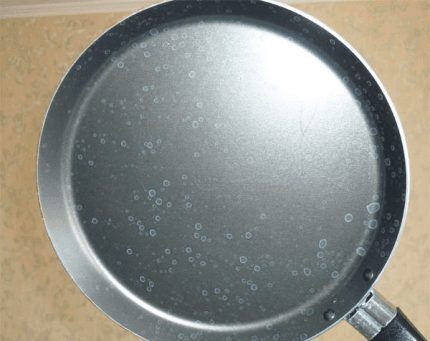
Checking the settings are correct
The setup procedure is usually described in detail in the instructions. Regenerating salt must be poured into a container intended for it. Sometimes inexperienced owners simply forget about this important point.
But just the presence of salt does not always solve the problem. It is necessary that the water is softened enough, but not excessively. Water that is too soft is not suitable for washing thin glass items.
To set these settings correctly, you need to accurately determine the hardness of the water that enters the dishwasher. If there are no test strips available for this purpose, you can try looking on the Internet. For example, on the Mosvodokanal website there is information about the characteristics of water in the city water supply.
The following video will help you correctly determine the composition of water coming from the central water supply system:
Problems with incorrect settings can arise not only at the beginning of operation, but also later. For example, if the water parameters have changed for some reason.
Therefore, if a white deposit appears, you should again check how hard the water in the tap is.The characteristics of autonomous systems are less susceptible to such changes.

Unscheduled cleaning of PMM
If, in addition to stains on the dishes, plaque is found throughout the dishwasher chamber, and a large amount of dirt and greasy deposits appear on the bottom, the appliance may not have been cleaned for too long. Cleaning is carried out using safe and effective means, which our recommended article will introduce you to.
Filters become clogged and contaminants penetrate into drainage devices. As a result, limescale that appears on the surface of the heating element enters the dishwasher chamber and settles on the surface of the dishes.
In addition, scale particles can get into the sprinkler openings. The gaps narrow, water enters the chamber with low pressure and in insufficient quantities. All this affects the quality of cleaning the dishes, and also contributes to the appearance of a white coating.
To fix the problem, you need to clean the dishwasher filters, and also perform such cleaning regularly in the future. If there is too much dirt or the filter is damaged, you should replace it with a new one.
In addition, it is necessary to carry out the procedure for descaling the machine. This should be done approximately two to three times a year using a product designed for this purpose. If it is unavailable, you can use vinegar or citric acid. Cleaning is performed at maximum heating temperature.
A detailed analysis of the dishwasher cleaning process is demonstrated in the following video:
When using homemade household chemicals, the dishwasher should be paused in the middle of the cycle for about one hour. The cleaning agent is used in accordance with the instructions.
Correct use of cleaning products
If white streaks or deposits appeared in the sink immediately after a new portion of regenerating salt was added to the container, most likely the filling was done carelessly and some of the crystals got into the washing chamber. This may cause deposits to appear on the dishes.
There are other ways salt can get into the dishwasher:
- if the container lid is not closed tightly enough;
- the cover is cracked or its position is skewed;
- An error occurred when adding salt; it ended up in the container intended for detergent or rinse aid.
It is best to add salt immediately before starting the wash cycle. Some manufacturers even recommend running the machine idle if, after filling the container with salt, you do not plan to use the household appliance for its intended purpose.
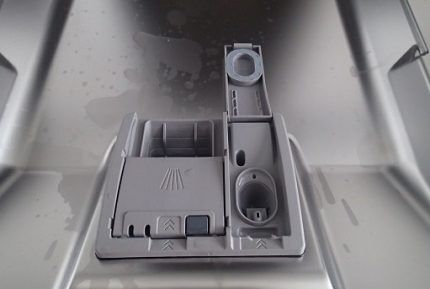
After adding a new portion of salt, you must screw the lid very tightly so that its granules do not fall into the chamber. After this, you should always check the condition of the chamber; if the product spills, you need to carefully remove it. If the lid is cracked, you cannot use the dishwasher; you need to buy and install a new lid.
Another common reason for the appearance of whitish streaks in the dishwasher is the use of low-quality household chemicals.To properly clean the surface of the dishes, you need to use three products: a stain remover, rinse aid and regenerating salt.
When conditioning drying, it is very important to add a sufficient amount of rinse aid, otherwise streaks may appear on the dishes even when the salt is fine.

Cost of quality dishwasher detergents is quite high, some housewives prefer to experiment with cheaper options, and these experiments are not always successful.
Especially many problems arise from “3 in 1” type products, which contain both a cleaner, a rinse aid, and salt. Even normal quality tablets, the proportions may not be suitable for your particular dishwasher or the water used in it.
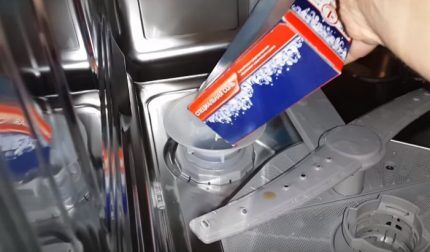
If the brand of detergent has recently been changed, this may be the cause of the residue.
Problems can arise even when using high-quality chemistry:
- if there is too little or too much powder or rinse aid;
- when the lid of the rinse aid container is not tightly closed or damaged, causing the product to enter the chamber during the wash cycle and mix with the powder;
- if the powder and rinse aid containers were mistakenly mixed up;
- if these consumables are loaded into the same container.
With “3 in 1” tablets, sometimes problems arise on short cycles, although with a long program the washing is done quite well.
This is due to the fact that during a short period of time the tablet simply does not have time to dissolve, and the quality of washing suffers from this. It is enough to adjust the correct supply of funds into the dishwasher chamber to eliminate the problem.
It is not always possible to purchase a suitable set dishwasher detergents or determine their optimal dosage immediately. Some housewives have to conduct several experiments to find the right combination. Of course, you need to take into account the manufacturer's recommendations in this regard; they are set out in the instructions.
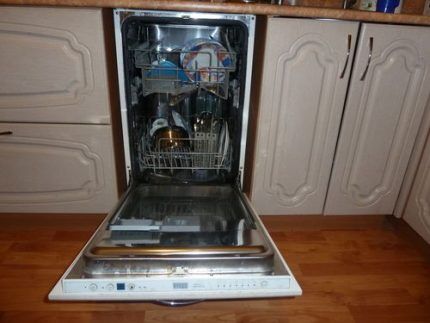
If all methods have been used and tested, and the plaque does not disappear, you may need to look for a more serious breakdown. Such situations are rare, but they do happen.
Usually, in the event of a breakdown, the appearance of plaque is found not only on the dishes, but throughout the entire chamber, and is also accompanied by a large amount of fatty contaminants. You need to call a specialist and order a detailed diagnosis of the device’s condition.
Often the result is that the stiffness sensor is broken. Such an element is not available in every device, but only in some, usually expensive, models.
Using this module, the required amount of salt is determined automatically. Replacement of the sensor should be carried out by a good repair specialist; this procedure is usually performed at a service center.
Advice from experienced owners
During use, customers discovered various ways to improve the quality of washing and cope with stains.It is noted that cheap, low-quality dishes are more difficult to wash in the dishwasher. Sometimes you have to replace some items with more expensive ones or completely change the brand.
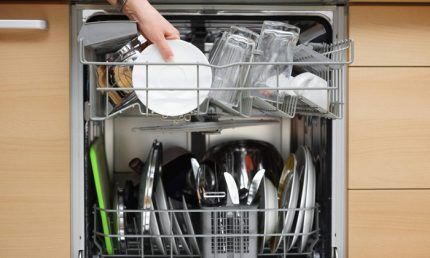
For certain items and depending on the type of contamination, you need to choose the right wash cycle. Also, do not exceed the number of items allowed for loading at one time. The number of sets is indicated in the instructions. Problems can also arise when dishes are placed incorrectly in the chamber.
On forums and review sites you can find a lot of useful tips for specific dishwasher models. It makes sense to carefully study such recommendations in order to learn not from your own mistakes, but from others.
It will help you understand the intricacies of the dishwasher, familiarize yourself with the parts of the unit and their maintainability. next article, which we highly recommend reading.
Conclusions and useful video on the topic
Video about the causes of plaque in the dishwasher and the most effective way to eliminate them:
Plaque on dishes is an unpleasant, but quite common phenomenon. It’s not difficult to get rid of it; you need to soften the water and clean the equipment in a timely manner. If the machine is operated correctly, the likelihood of problems occurring will be minimal.
Want to talk about a simpler and easier way to get rid of the white mineral deposits that form in your dishwasher? Do you have an effective technique that is worth sharing with site visitors? Please write comments in the block below, ask questions and publish photographs on the topic of the article.




Our tap water is almost always very hard, so it is important to correctly set the hardness level in the dishwasher settings. Some machines even come with strips for testing water. Or you can call your local water utility and check with them. It is also important to periodically add regenerating salt to the container and check the filters and, if necessary, clean them. Then there should be no problems with white plaque.
At first, after installing the dishwasher, no white residue appeared on the dishes. Following the instructions, I poured in the required amount of salt for washing dishes and used only high-quality detergents. But after about a year I began to notice it on the dishes. I searched for the reason for a long time, until one day, during a conversation with a friend, the conversation turned to water hardness. She said that the water had become harder. I changed the settings and the white residue disappeared.
I add a teaspoon of citric acid along with the powder. Then no white residue remains, and the dishes sparkle. I wonder what the service life of the PMM ion exchange filter is and is it possible to change the resin in this filter?
I just pour a little citric acid into the rinse aid container each time. Everything sparkles. Before this, no expensive remedies helped.
Elena, please tell me, do you add citric acid along with the mouthwash? or without rinse aid